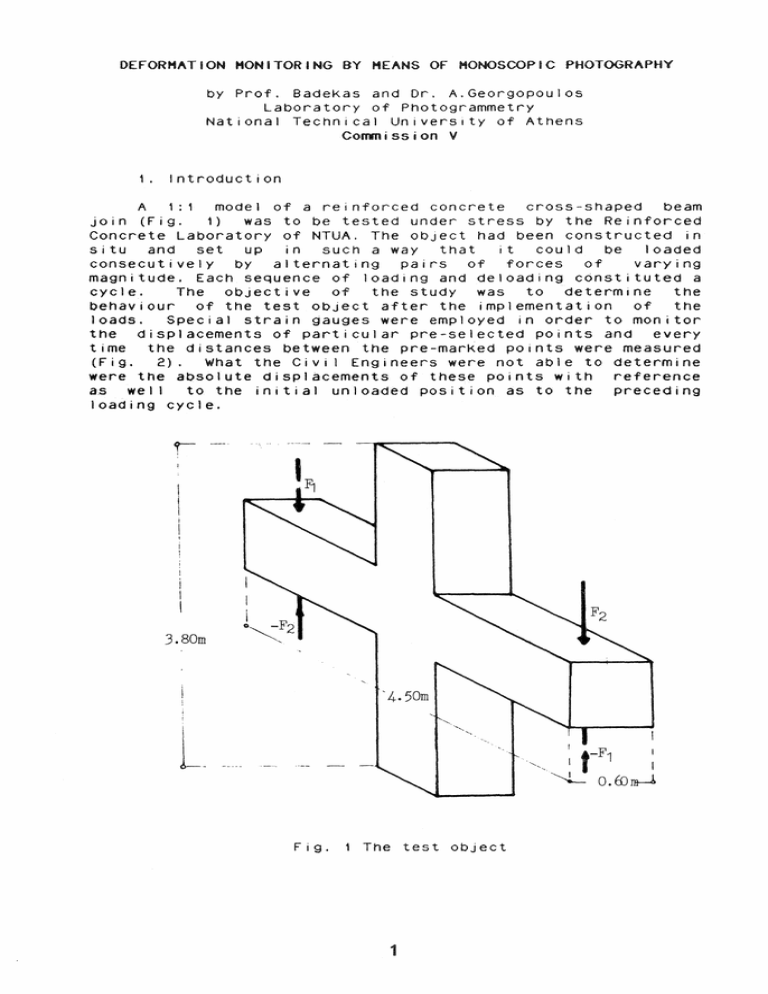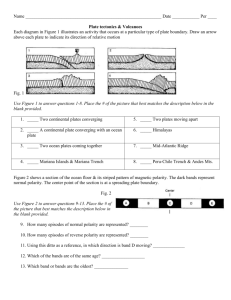by Prof. BadeKas and Or. ... Laboratory of Photogrammetry
advertisement

DEFORMATION MONITORING BY MEANS OF HONOSOOPiC PHOTOGRAPHY by Prof. BadeKas and Or. A.Georgopoulos Laboratory of Photogrammetry National Technical University of Athens Commission V 1. I ntroduct ion A 1:1 model of a reinforced concrete cross-shaped beam join (Fig. 1) was to be tested under stress by the Reinforced Concrete Laboratory of NTUA. The object had been constructed in situ and set up in such a way that it cou 1d be loaded consecutively by alternating pairs of forces of varying magnitude. Each sequence of loading and deloading constituted a cycle. The objective of the study was to determine the behaviour of the test object after the implementation of the loads. Special strain gauges were employed in order to monitor the displacements of particular pre-selected pOints and every time the distances between the pre-marKed pOints were measured (Fig. 2). What the Civi 1 Engineers were not able to determine were the absolute displacements of these pOints with reference as wei 1 to the initial unloaded position as to the preceding loading cycle. 3.80m '4.50m Fig. 1 The test object 1 to A fast and simple photogrammetrlc procedure was be chosen In order to determine these displacements within an accuracy of 1-2 mm. As these dIsplacements were forced by the setup of the experiment to be confined to the front plane of the object a monoscopic procedure was employed. 2. The Photogrammetrlc Procedure In order to es tab I j sh a reference sys tem for aII photogrammetrlc data, a plane frame was hung independantly just in front, and parallel to the test object tn such a way that it remained uninfluenced during the loading cycles (Fig. 2). The frame was rhomboidal In shape. bear'ing 8 targetted points (contro 1 po i nts). The d I stances between a 11 these ,. contro J points were measured directly on the set up frame with submi It imetre accuracy. These were the only geOdetic measurements carried out for this proJect. J Fig. 2 Plate #1, zero loading A ZEISS JENA UMK 1318/100 metric phototheodol ite was employed for the photography from a distance of approximately 4.0 m, thus giving a 1:40 scale. Glass plates were used t~ reassure maximum flatness of the negative. With the help of the horizontal circle of the UMK, parallel ity of the negative and the test object, as wei I as the frame was achieved. Thus scale variations within the same photograph were minimised. The tripod and the orientating part of the UMK remained undisturbed during the whole experiment. Photographs were taKen after every loading cycle. Seven plates were taKen in alI, including the first one, which was taken before any load implementation in order to serve as the basic reference (Fig. 2). A Stereoplanigraph C8, used as a monocomparator (Exintavelonis et al.), was employed to measure co-ordinates on the plates. The points observed on each plate were: a. The 4 fiducial marks b. The 8 ~control points~ on the reference frame c. 18 of the pre -marked po i nts on the test object, distributed evenly on the front surface d. 4 pOints marKed on the steel beams supporting the object, in order to monitor eventual displacements on them as weI t. Each point was observed three times and the measurements were directly stored in an HP-9845S desktop computer. 3. Data Processing The data was transfered to an ALTOS 586 of the Laboratory of Photogrammetry, which is worKing under a XENIX environment. All the computer programmes developed for this appl ication were written in Microsoft FORTRAN 77, v.4.0. Firstly mean values of the observations were calculated and the standard deviation was determined at 12 ~m. The mean values were referred to a cartesian co-ordinate system defined by its x-axis being the 1-5 1.ne on the frame (Fig. 3) and point 1 being the origin. USing the measured distances on the frame the mean value for the scale of each plate was determined. The study of the scale factors of the plates indicated that at least plates #2, #3 and #4 were taKen with a phi rotation. 3 'Y 8 7 Fig. 3 The control and the reference system Projective transformation of al I frame point observations onto the first plate was chosen to be the best solution. Several deterministic models were tested and implemented. The one chosen included a scale factor, two translations and two differential rotations. The criterion for choosing this model was the a posteriori 00 of its fit, which was 0.305 mm. r ., I x I I y I I c I L r = ..J K I 1 I 0 I !lq> L o ., I I 1 I -l.\q> l.\w ..J r I X I I Y I I C I L r ., ..J + ., I l.\X I IllY I I 0 I L ..J Based on the fact that the control pOints on the frame remained undisturbed for aJ I plates. the parameters for the transformation of each plate to the first one were determined. Using the same transformation the observed co-ordinates of the pOints on the test object were also transformed to the first image. Thus point co-ordinates in the same reference system and in the same scale were produced. A simple subtraction of the co-ordinates of a point on the different plates would produce its absolute displacement. In Figs. 4 and 5 the displacements are plotted. In the first one (Fig. 4) the displacements between plates #1 (zero loading) and #2 are pl~tted, whi te in the second one (Fig. 5) those between plates #1 and #7. 4. Conclusion . By applying formations have this been photogrammetric procedure. the dedetermined, both in magnitude and N· TaU · ATHENS LABORATORY OF PHOTOGRAMMETRY POINT DISPLACEMENTS ON TEST OBJECT UNDER STRESS S1· 1-- S2· 2Y .." J . CO 01 ~ N ~ ge ~ LOADING CYCLE #2 N S 41 I~ 1~ 1re S- 7, 8\ S lOe 140 IS, 16r I". +0.8 MY -0.8 MY SCALE S~ S3· 10 1111 !-----I NeT . U D ATHENS LABORATORY OF PHOTOGRAMMETRY POINT DISPLACEMENTS ON TEST OBJECT UNDER STRESS Sl~ '"'rJ m 1\ J CO j 6____ 5e ()1 N 11'~ So 2~ Sf --we tOe 14~ 7~ 15 \ S 16 1 TOTAL DISPLACEMENi 17-- IS. PLATE 1 - PLATE 7 SCALE S4.... S3~, 10l1M 1-----1 direction. The accuracy of the determined deformation is of the order of 0.5 mm, which, combined with the information provided by the strain gauges was considered more than adequate for the test. It has been shown that simple photogrammetric procedures may well contribute to deformation monitoring with an acceptable accuracy. Reference 1. Exintavelonis, J" Patas, J., BadeKas, J" 1981. ordinate measurement on a Stereoplanigraph 9 r a mm e t r 'a 36 ( 1 9 8 1) p P . 10 1 - 109 . I 7 Image coPhoto- C8.






